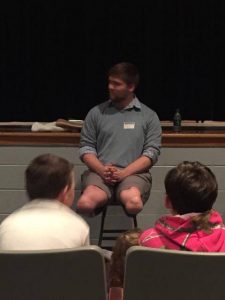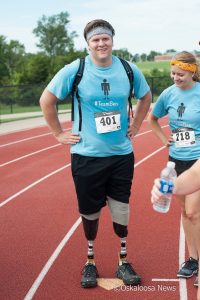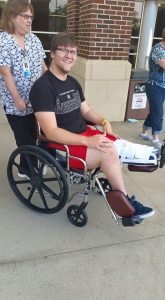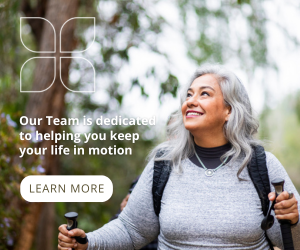A Tough Decision Appears To Be Paying Off
Oskaloosa, Iowa – Life changing decisions are often scary because, even though we may believe we know how they will turn out, there are no certainties.
Ben Akers graduated from Oskaloosa High School in 2013, and was a visible person within his class and the community. That activity came with a price though.
Akers was born with severe club feet and, when he was young, underwent many corrective surgeries for the condition. Akers says the first of those surgeries happened when he was just 6 months old. The surgeries continued at regular intervals until the age of 4.
Akers said things worked pretty well until he was approximately 14 years old. As with most adolescents, growth comes on quickly and his feet and ankles couldn’t keep up with his growth rate. “I started to just break bones in my feet through day to day activity”.
Akers remembers trying to run in physical education one day, ultimately breaking a bone in his foot. “I was just running across the gym, and it popped.”
Akers was told at that time that physical activity wasn’t advised because his feet would continue to break.
This news sent Akers and his family looking for options to try and “help the issue”. Trips to the Mayo Clinic and the University of Iowa for reconstruction options. Those would have involved multiple surgeries potentially over a five year span. The success rate offered only included a 70 percent chance of less pain, but his physical activity would still be diminished. “I wouldn’t be able to run. I wouldn’t be able to do anything like that”, says Akers.
There was also the 20 percent chance nothing would change, and even a 10 percent chance things may get worse with the surgeries.
“At 20 years old, I didn’t like those numbers”, added Akers.
Thus began the search for other options; Akers “found amputation as an option”.
While researching other options, Akers became aware of a person from the United Kingdom that was born with a single club foot. This person had also undergone scores of surgical treatments before amputation was performed.
“At that point in my life, I was thinking I don’t want to go through 20 more surgeries”, said Akers.
Akers found a surgeon that was willing to help and perform the amputations, and as of June 30 of 2015, Akers was a single amputee. By the end of September, Akers was a double amputee.
That decision for Akers didn’t come lightly. Akers, who was working in retail, couldn’t work over six hours. After such a shift, Akers would then be bed-fast for up to three days afterwards “just from the sheer amount of pain. I could not stand up. There were times I would try to stand up and my ankles would just give out and I would fall over.”
“I obviously got really frustrated with it, (foot and ankle pain) and just got to the point where I couldn’t take it anymore”, added Akers of life before the amputations.
“I did a lot of research on amputations before I even talked to my parents”, says Akers.
Akers then spoke to his parents in October of 2014 about his decision to move forward with the amputations.
“Mom cried a lot”, says Akers of his mother’s reaction. “It was hard on her, and Dad was in denial a long time that this is what would give me the best opportunity”.
Akers says that he was good at hiding pain, and his parents and others didn’t realize before just how much pain he was in. “It was just a fact of life for me. It was something you got used to, and you lived with”.
“After my first surgery, it was a few hours later on the day of surgery, I was laying on the hospital bed, and my left leg, which is the one I just had amputated hurt less than my right foot. At that point in time, I knew this was the right decision”, said Akers. “I was hours out of surgery, and it already hurt less.”
That relationship with his parents since his surgery has changed. “They have seen my life change, and they are happy for me now. They know I made the right decision.”
Akers did as many people do, he turned to social media as an easy way to keep his friends and family, and the many other well-wishers, updated on his progress. “I started that while laying in the hospital bed the night after my first surgery”, says Akers.
Akers said that overall, people were very positive for him, considering what may be considered a taboo topic like amputation, because it is often associated with a traumatic type of incident.
“In my case, it was such a positive thing for me, I enjoy talking to people about it. I’ve had little kids walk up to me and ask what’s wrong with my legs. I will sit there and talk to them. It’s a very positive thing for me and my life”, says Akers. “I’m just trying to lessen the taboo about it.”
Akers says he never really faced any criticism over his decision, but he did field many questions about his decision to move forward with amputation. “But I never had any accusations or anything else along those lines.”
Having all of the positive support helped Akers as he began his recovery process after the surgeries. “It made it a lot easier to go through the recovery, because the recovery was tough.”
Akers faced physical therapy twice a week for months.
Akers does have some phantom limb syndrome, but it amounts to little more than a tingling sensation where the ball of his foot would be, and near his toes. He believes that he is lucky to have very little of the syndrome, due to the fact his went into surgery with limbs that had not suffered a traumatic injury.
Akers is now between 6 foot 3 or 4 inches tall once again. A switch from being 6 foot for quite awhile.

Akers talks with others about his experiences. He hopes that by talking about amputation, it may help lessen some taboo on the subject. (photo used with permission)
The shorter prosthetics allowed Akers to better acclimate himself to walking on his new feet, by lowering his center of gravity. “That was kind of a shock for me because I’ve always been fairly tall.”
Akers once again sees many possibilities in life. He’s returning to college, something he had to leave because of his foot pain. His plan now is to pursue an education in prosthetics and orthotics, with the ultimate goal of working with the Shriner Hospital or St. Judes to build prosthetics for children who have lost limbs.
When it comes to the biggest changes in life, “It’s waking up in the morning and having to put my legs on”, says Akers. “The other thing is, I can order shoes online. My feet are a size 12, and they’re a perfect size 12.”
That humor and positive attitude is what keeps carrying Akers along in his journey, which included being able to run once again.
That goal is something he was able to complete just this weekend at the MHP ‘Run in the Sun’, when Akers completed his first 5k race. He finished the race with a time of 56.15, and he says it’s the first of many to come.


















